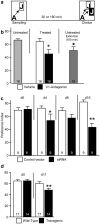An intrinsic vasopressin system in the olfactory bulb is involved in social recognition
- PMID: 20182426
- PMCID: PMC2842245
- DOI: 10.1038/nature08826
An intrinsic vasopressin system in the olfactory bulb is involved in social recognition
Abstract
Many peptides, when released as chemical messengers within the brain, have powerful influences on complex behaviours. Most strikingly, vasopressin and oxytocin, once thought of as circulating hormones whose actions were confined to peripheral organs, are now known to be released in the brain, where they have fundamentally important roles in social behaviours. In humans, disruptions of these peptide systems have been linked to several neurobehavioural disorders, including Prader-Willi syndrome, affective disorders and obsessive-compulsive disorder, and polymorphisms of V1a vasopressin receptor have been linked to autism. Here we report that the rat olfactory bulb contains a large population of interneurons which express vasopressin, that blocking the actions of vasopressin in the olfactory bulb impairs the social recognition abilities of rats and that vasopressin agonists and antagonists can modulate the processing of information by olfactory bulb neurons. The findings indicate that social information is processed in part by a vasopressin system intrinsic to the olfactory system.
Figures




References
-
- Donaldson ZR, Young LJ. Oxytocin, vasopressin, and the neurogenetics of sociality. Science. 2008;322:900–904. - PubMed
-
- Frank E, Landgraf R. The vasopressin system--from antidiuresis to psychopathology. Eur. J. Pharmacol. 2008;583:226–242. - PubMed
-
- Ferguson JN, et al. Social amnesia in mice lacking the oxytocin gene. Nature Genetics. 2000;25:284–288. - PubMed
Publication types
MeSH terms
Substances
Grants and funding
LinkOut - more resources
Full Text Sources
Other Literature Sources

